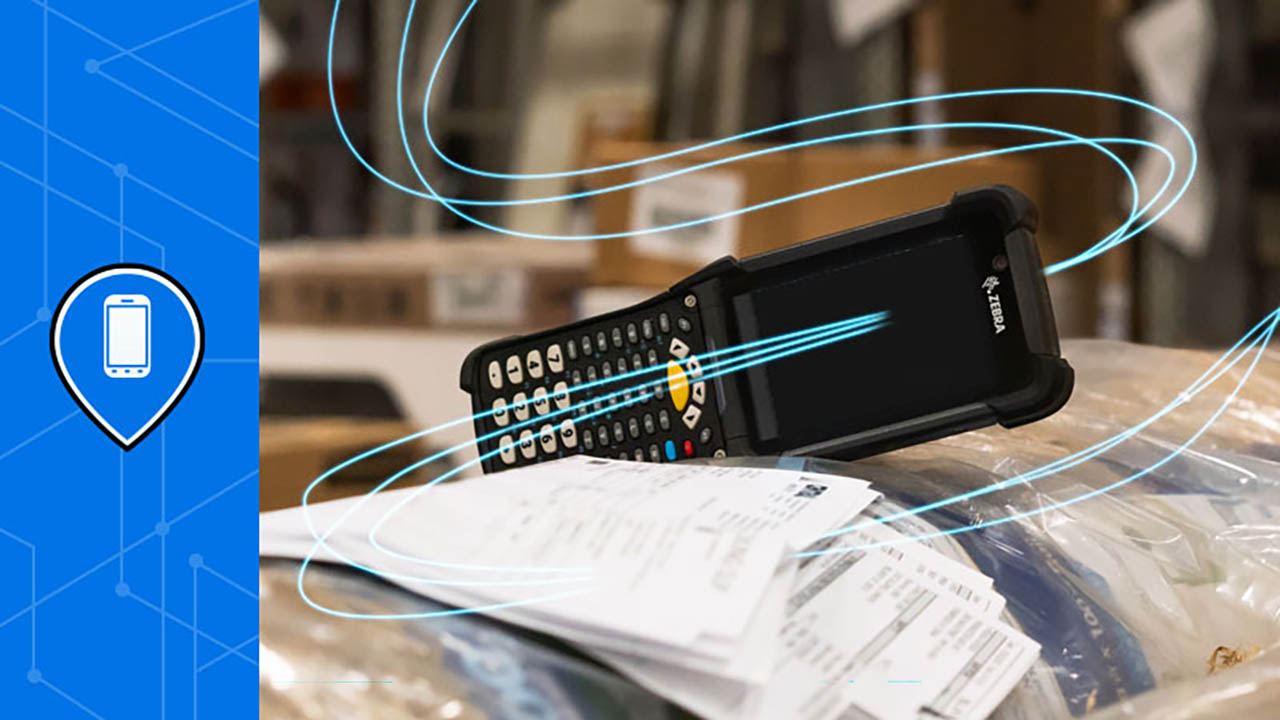
Did You Know? Device Tracker Can Notify You When You Are Near a Zebra Mobile Device That Is Idle Too Long, Going Offline, or Missing.
I don’t have to tell you how important Android™ mobile computers have become to your business’ success. If you didn’t have technology available to help guide you and your team through each task and your entire to-do list, life would be hard. (I remember what the pen and paper days were like.) Front-line workers would have to guess where to go and what to do next. They weren’t able to submit real-time status updates to others involved in the workflow, nor could they be able to collaborate with others to ensure the best outcomes for customers, patients, partners or your business. Essentially, they were working in the dark, hoping they were making the right decisions and very few mistakes.
I want to help ensure that does not remain a struggle by showing you how to make your Zebra Android mobile computers visible even when they are out of sight and possibly even offline.
Zebra Device Tracker’s New Features Help You Take a Proactive Stance Against Losses
Last year, I wrote about the many benefits of the Zebra Device Tracker software here on the Your Edge blog. Several of you then called to share your enthusiasm about this new tool with me and my colleagues around the world. Finally, you could recover devices that disappear throughout the day versus having to spend thousands of dollars looking for or replacing them.
I understand the excitement. Retailers tell us that before a cloud-based tool such as Device Tracker existed, they would lose 10% of their entire mobile device fleet each year on average. Healthcare providers were losing even more. Those aren’t nominal numbers when you consider the sticker price of mobile devices, much less…
- the lost productivity that occurs when workers must search for missing devices and/or work without devices.
- the increased risk that workers will make the wrong call or an accidental mistake when they don’t have real-time access to the right people or information.
- the IT labor costs associated with looking for and locking down missing devices and then ordering, configuring, securing, and deploying replacement devices.
- the shipping costs associated with getting replacement devices to the right facilities or field-based workers as quickly as possible.
- any software development work required when missing devices must be replaced with newer models running different operating systems.
- the security liability associated with missing devices. If a bad actor finds the missing device, or the device was intentionally stolen and never recovered, they could potentially access sensitive data and business systems, making your business vulnerable to much larger losses.
Zebra’s Device Tracker tool proved to be just what you needed to minimize, if not completely eliminate, these expensive device losses. But even the best tools can be improved upon, especially technology tools. So, my team and I have been looking at ways to make Device Tracker even better. We realized that you would benefit from four key changes:
1. A more simplified web dashboard
2. A historical log of which employees have used each shared device
3. An automated notification system for “at risk” devices
4. A way to crowdsource missing device locations
So, we have added new capabilities to deliver these benefits:
1. We simplified the look and feel of the Device Tracker web dashboard to make it easy for device administrators to see the status of your fleet. It doesn’t matter if IT managers and operations managers are remote or just busy, they can login to any internet-enabled device, pull up Device Tracker, and confirm the real-time status of all Zebra Android mobile computers your company has deployed. Site managers can also subscribe to an end-of-day report to get an emailed a status summary of all on-site devices. If they need to run a time-restricted snapshot report, it’s as simple as a quick date filter. They can even drill down into device utilization data for certain sites so you can better track which devices are being over or underused and which aren’t being properly maintained by workers (i.e., batteries are being drained to zero before a worker attempts to recharge).
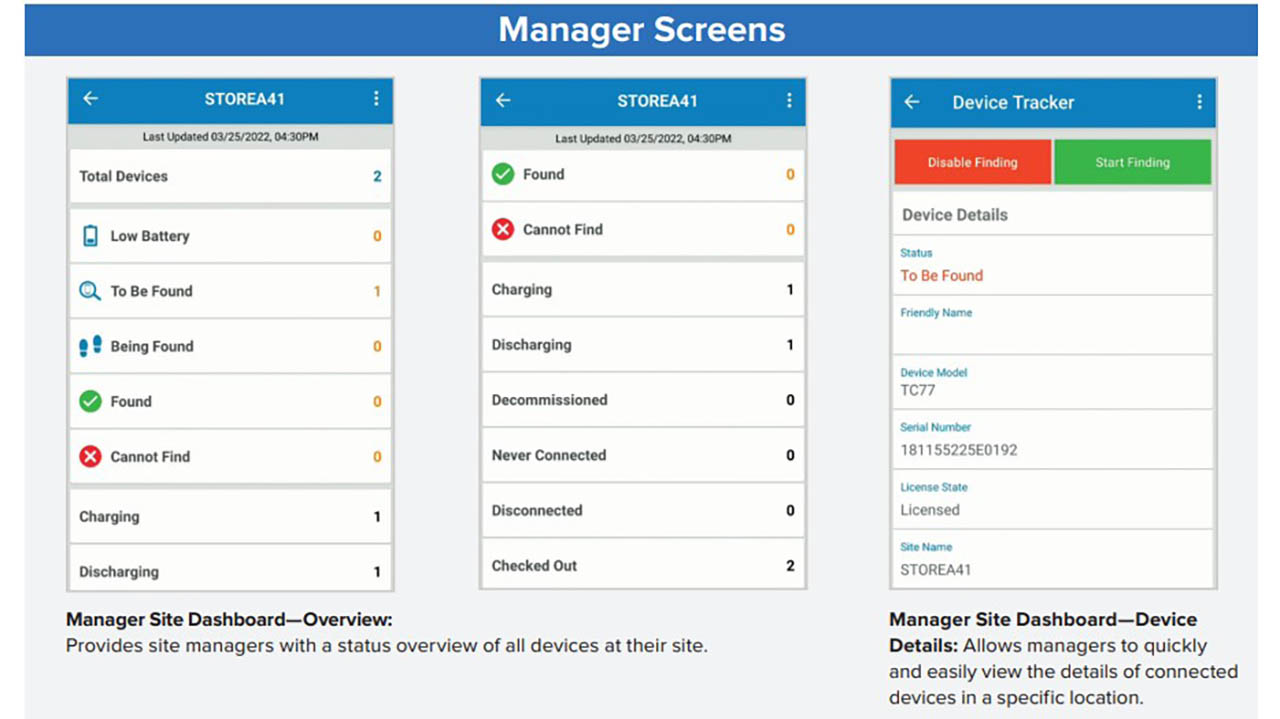
2. You now have a way to set “device thresholds,” which are basically warning signals that a device is about to lose power or that it has been sitting in the same place for too long. Once a “low battery” or “device idle” threshold has been confirmed, the Device Tracker platform will automatically flag the at-risk device as “To Be Found” and notify you and other key stakeholders. The hope is that this will help you pull the device out of service before it completely powers down. If it has been idle, this feature should help you jump start the search, as you’ll be able to quickly see who was using it last and where it was last pinpointed on a facility map.
3. Workers can now “check out” and “check in” devices using a quick badge scan or Single Sign On (SSO). Device Tracker makes integration with your company’s user authentication system seamless so you will be able to assign a user to a device, creating more accountability and responsibility for the device. Admins and managers will also be able to log into their Device Tracker Dashboards and be presented with the appropriate access and information for their roles. If a device needs to be recovered, you can immediately contact the last known person to have it in their possession. If they are no longer using the device or realize they did leave it behind somehow, then you can proceed to using the next new feature: a real-time notification and call to action. In addition, if there is an issue with a device, you can identify all historical users as needed for IT troubleshooting.
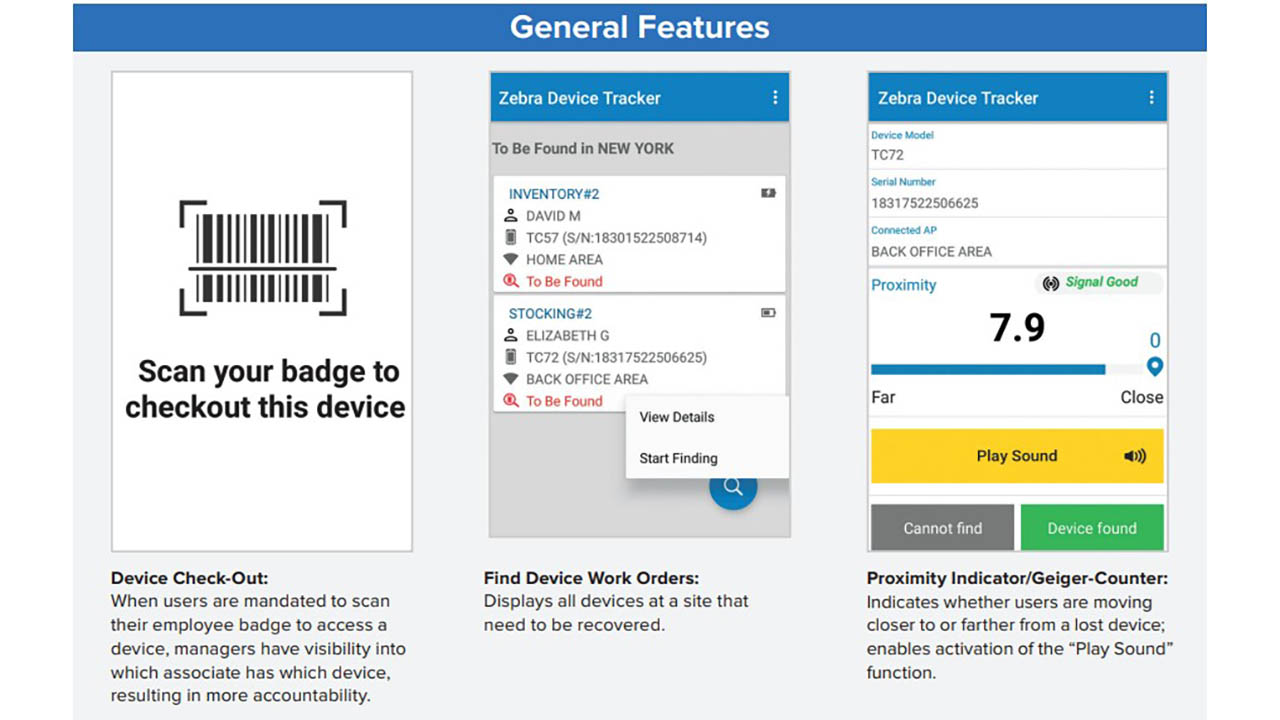
4. You can program the system to automatically notify employees who may be in the vicinity of a device that has been reported as “to be found” because it has not been returned or has been idle, disconnected, or powered off, so they can help with recovery. Your IT and site ops teams won’t have to constantly go into the dashboard to manually monitor device status. If a device hits a certain threshold or is reported missing, an automated push notification will initiate the recovery process. Notification recipients will be prompted to open the app and the first person who acknowledges the alert will be directed in the general location of the device that needs to be recovered (i.e., home goods). The notification will then be cancelled for all other recipients so they can get back to work. The employee who accepted the task of finding the device can remotely ring the device during their search in case the device is out of sight. Between the Bluetooth Low Energy (BLE) beacon signaling and audible ringing system, the likelihood of a positive outcome – a rescued or recovered device – significantly increases. In fact, during our real-world testing, our teams were able to recover all devices within minutes, including those that were powered off.
5. We have added support for BLE-enabled batteries so devices can still be recovered even if they appear offline due to a drained battery or intentional power shutdown. Any worker using a BLE–enabled Zebra Android mobile device can launch the Device Tracker app, instantly see the list of Zebra devices reported missing by colleagues, and then use the built-in Proximity Indicator to locate missing devices that are nearby. If the reported devices have been equipped with the optional secondary BLE, they will be trackable even if powered down. Essentially, the Proximity Indicator will tell workers if they’re hot or cold on the trail of missing devices. They’ll be able to see in real time if they’re moving in the right direction and confirm when they’re closing in.
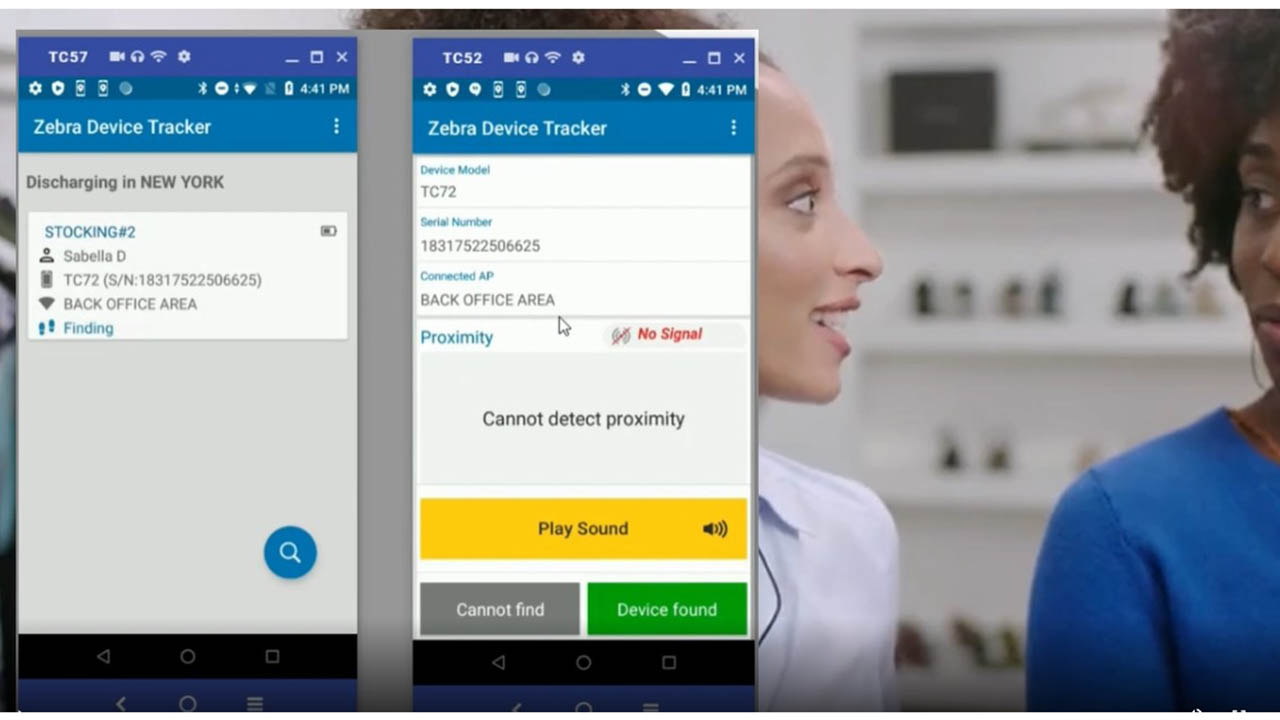
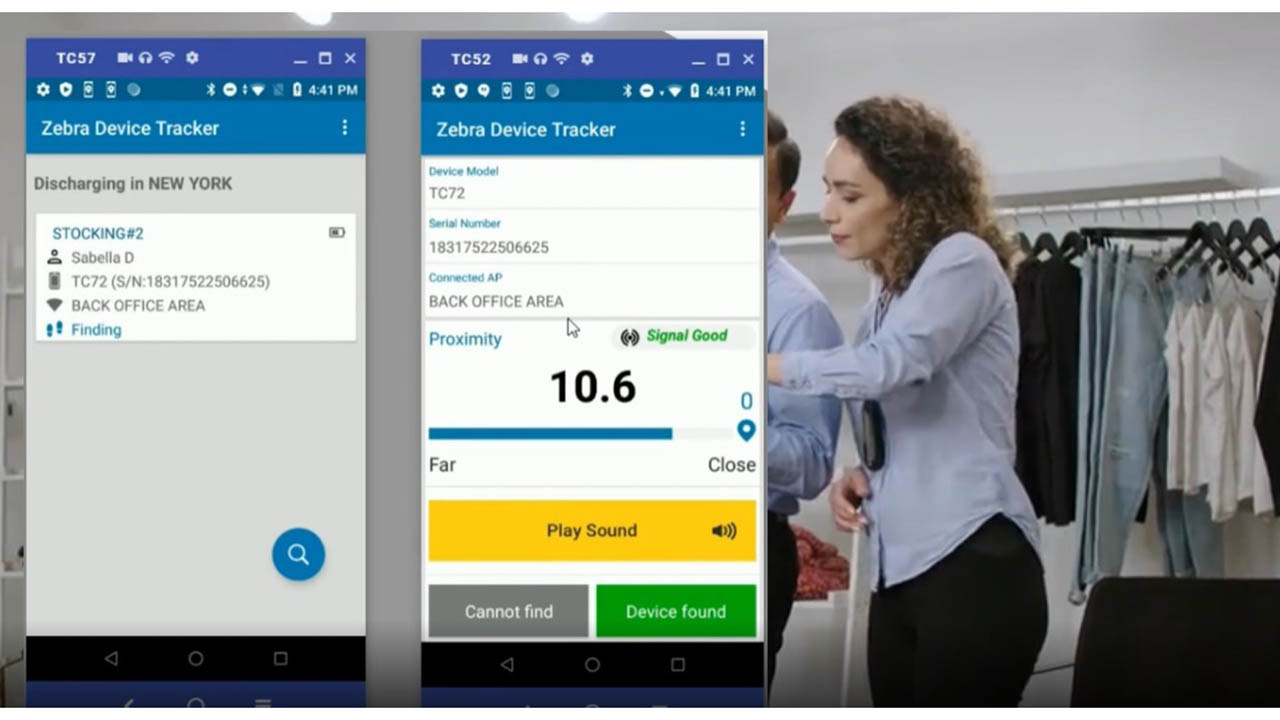
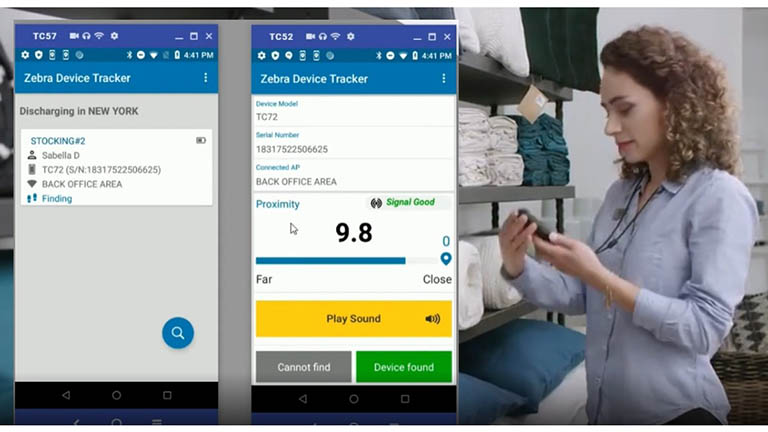
Watch this:
How to Take Full Advantage of These New Features
If you want to see the incredible value that Device Tracker can bring to your business, here’s what you need to know:
This is a licensed application/subscription service. However, you can get a one-year, three-year or five-year license/subscription for each device in your fleet (scalable to up to more than 100,000 devices across up to 5,000 sites).
The licensing fee/subscription gives you everything you need to configure, deploy and maintain the Device Tracker service for each device in your entire fleet. You’ll receive access to managed services and technical support. The initial setup just requires you to configure the system for your environment and download the Device Tracker client application onto your devices via your enterprise mobility management (EMM) platform or Zebra’s complimentary StageNow staging tool. If you need to include additional licenses down the road, you can do so easily and co-term the licenses to align on renewal dates.
You won’t need to spend any capex on additional infrastructure or software. No special servers, APIs or BLE devices are needed to use Device Tracker’s fundamental auto-tracking and notification capabilities. This is a 100% opex expense (beyond the mobile devices, of course). However, you will need to ensure you buy devices or batteries that have that second BLE sensor if you want to be able to track them when they go offline. Talk to your Zebra sales representative about the hardware models that offer that extra sensor.
All licensed devices’ status can be viewed on the same web dashboard by any employee who you’ve granted the appropriate dashboard access level. Administrators can see the entire fleet, managers can see all on-site devices, and front-line workers can see all missing devices.
I don’t have a crystal ball, but I am pretty confident that if you commit a small investment now to this updated cloud-based Device Tracker toolset, you’ll save a significant amount of money in the long run. The days of replacing 10%+ of your fleet each year will finally be behind you.
###
Editor’s Note:
If you would like to learn more about Device Tracker or have specific questions about how it would work with your current Zebra Android mobile computers, please visit our website or contact your local Zebra representative.
###
Related Read:

David Degrassi
David Degrassi is currently a Product Manager at Zebra where he is responsible for Zebra’s Enterprise Mobile Computing Software Solutions.
David has more than 17 years of experience within the mobile industry and has managed Zebra’s Mobility DNA software, including StageNow mobile configuration tool and EMM Toolkit. David currently manages Device Tracker and Enterprise Home as well a host of other valuable utilities such as Device Central and Battery Manager.




